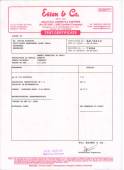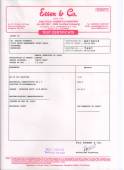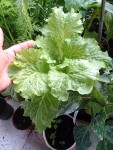Among almost all urban farmers, interest in composting seems to be a frequent corollary of their passionate love for organic gardening, or vice versa. Bengaluru, despite being the epicentre of garbage crisis, can be distinctly conscious of this silver lining and take obvious pride in it.
That said, in our pursuit to transform food and garden waste into small black particles, have we let the art of composting sidestep the science of composting? Is this a silly, juvenile romance with composting conveniently aided by the earthy aroma of moist humus? Worst of all, are we deluding ourselves into thinking that whatever we touch becomes “Black Gold”?
Busting these ‘myths’ was anything but a herculean task. All it needed was getting a few compost samples subjected to scientific scrutiny in a good material-testing laboratory. The samples came from composting expert and avid urban farmer Vani Murthy’s ‘factory’. They were Bokashi, vermicompost and Daily Dump—the methods which Vani has been using to transform all her food and garden waste into compost.
But no, it was not doubt that triggered this trip to the lab. It was curiosity. A deep-seated desire to know what exactly resides in the dark realms of a fistful of compost. No, it was not about promoting any particular vendor or method. These methods just happened to be the ones practised and perfected by Vani over five-plus years.
“Too numerous to count”
All the three tests revealed one fantastic feature on “microbial load”: “Too numerous to count”!
How does it feel to be surrounded by this invisible force of nature? Says Vani: “I can’t see them but I can feel them, smell them in my compost—my magical soil-enhancer that grows my healthy veggies. The richness of the compost tells me that I have a huge army on my terrace. All they need is to be fed with my kitchen leftovers to create their magic. The idea that I am able to make alliance with these unseen ‘micropals’ that work tirelessly, creating magic with my kitchen waste overwhelms me.”
All the headaches over C:N, pH, EC…
Sir Albert Howard, the father of organic farming, once said: “Compost is a creature of circumstances”. It is difficult to take out balanced compost with perfect pH, C:N or EC each time you harvest a potful of compost. What goes in decides what comes out. Put simply, you reap what you sow. Should one be so perturbed about a teeny-weeny spike in carbon-nitrogen ratio? Should you let this pip-squeak of a number overshadow your love for composting?
Let’s put our common sense to use: There is no way your plants will continue to glisten in the sun if every slight anomaly in the readings of these essential parameters were to cause irreparable damage. It’s as simple as that. Check out this gallery to see the glory of organic terrace gardening, Vani Murthy’s labour of love.
The tyranny of specialisation
There are times when we surrender ourselves to the tyranny of specialisation, we tend to consign common sense to a bottomless bin. We forget that our previous generations simply dug a pit, sprinkled a layer of soil and then let nature work its creative magic on it. In villages, farmers heaped it up (they still do) with generous amounts of cow and buffalo dung, chicken manure and other organic material and went on stacking straw on it layer by layer. They didn’t give two hoots to C:N ratio or pH level. Generations have not only survived but also thrived on this compost which went back to the soil and gave bumper crops. At least it’s been so with my family farms.
Missing the woods for the trees
When we get too involved in discussing these parameters, we forget that composting is a natural occurrence which keeps life flourishing all over the planet. Yes, when forced into a controlled environment like our balcony, utility area or apartment complex, we will not have the freedom that our rural counterparts have. Specialisation to prevent odour, rats, flies, etc., has to come in. Then comes the inevitability of discussing C:N ratio, pH value, EC and what not. But let’s not forget that it is also composting that very much mimics the natural process. The only difference here is that it’s been accelerated with specialised aids. That’s all.
At the same time, nobody is denying the importance of well-balanced compost. What is being stressed here is the futility of missing the woods for the trees.
As the above test results make it clear, your own compost can add “too-numerous-to-count” load of microbes to the soil. Even if you go wrong repeatedly, do not lose heart because each time you are close to cracking it. Let it begin as a science and achieve artistry as you move on. Your efforts are priceless because you are saving the soil from synthetic fertiliser and pesticide pollution.
“I feel so very privileged to be able to talk about microbes and help people understand the simplicity of their job to keep their soil alive and keep their waste away from landfills,” adds Vani.
Put simply, please go ahead and compost. It is too precious to be wished away over silly doubts and a terrible waste of resources to be dumped in landfills.
Happy New Year!



















Very interesting and intriguing article and encouraging facts. Can you have macro(NPK) and micro (Mg, MN , Boron etc.,) nutrient constituent levels analysed objectively… it will help to add more logical value to this priceless information in the article
LikeLiked by 1 person
Sure, Sathish. Will make a sincere attempt. Thanks for the comment. 🙂
LikeLike
Hi, I think these are not enough parameters. Ideally compost needs to be hygienized before usage to ensure there are no pathogens as MSW compost has high probability of pathogens, especially salmonella. The microbial count should be very low.
LikeLiked by 1 person
Dear Vishwas,
You are right. Pathogens are an issue. But most of them get destroyed during the thermophilic stage. The research that I have dug into tells me that pathogens do manage to survive even in ‘hygenised’ compost but they are far outnumbered by their counterparts. So their presence does not pose a severe threat.
What I am referring to here is not composting municipal solid waste but household wet waste. I can easily extend it to composting at apartment level as we have been doing it. The third stage in composting, I mean the thermophilic stage, is enough here to take care of the pathogens.
As far MSW, yes, a lot more care has to go into it because the collection, storage and then composting at such a large-scale cannot be as steamlined as is done at individual/apartment levels. If the waste is stored for more than a day, pathogens begin to breed instantly. Also, the chances of anaerobes entering the pile are very high.
Thanks for chiming in.
Savita.
LikeLike
Thanks. But not all pathogens get killed during thermophilic stage, especially if the is not controlled. There are lot of microorganisms such Enterovirus, Shigella, Salmonella, etc and Salmonella must be used as an indicator. It is usually safer to take the compost through a hygienization phase of 55 degree celsius for two weeks or 65 degree celsius for one week. I know this will be impractical for smaller units but ideally these conditions are preferred and most of the good standards in the world have this. Even the wet waste from households can have pathogens. My concern here is that the microbial content mentioned in the report sounds alarming and not the other way because we don’t know what are the microbes. My suggestion is that when compost tests are done, we need to check for phyical & chemical characteristics and pathogens. To check if the compost is mature or not, especially if it is going to be applied to fields, instead of visual inspection it will be better if we can check the respiratory activity of the sample. This is a very simple test and can be performed by any lab. Just a suggestion.:-)
LikeLiked by 1 person
Dear Vishwas,
The focus of this particular post is to encourage people to start composting first and deal with all the subsequent issues as they move on. I have come across some who give up on composting (this is what I meant when I said, “missing the woods for the trees”) because they get way too worked up about certain parametres. More will be written about compost in future and pathogens is one of the issues, of course. Please pass on all the relevant info, especially on the hygenisation process, That would help the readers immensely. I will also add my own views on it based on my research.
BTW, one of our gardeners whose job was to spray chemical pesticides in our community garden used to vomit and faint after each episode of spraying and would generally skip work the next day. He used to complain of severe stomach pain and headache. ‘Recovery’ used to be slow and before he could breathe easy, he used to be sent back to his routine. Since June 2013, we have been using the compost (both vermi & kitchen waste) for our garden.
I cannot tell you about how beautifully the garden has been disabusing itself of the chemicals and synthetic fertilisers. All the grass beds and other plants have turned green (earlier we had large brown patches). It is the same garden which was subjected to 600 litres of pesticides each month and many bags of synthetic fertilisers. Contrary to my own fears, it so gracefully withstood the sudden withdrawal of these deadly things and got used to organic soil enrichment processes. Fungal infections have reduced drastically. We hardly use certified organic pesticides and that too, for only those infected plants. Earlier, pesticides was a routine to prevent recurring infections in the plants. As for the gardener, he has not complained once about any issues over using the compost. None of the remaining 9 gardeners has complained about any issue either. I have been using compost for over two years now and I have not faced any pathogenic infections. So is the case with all my compost-enthusiasts friends who have been into this activity for years.
What is unfortunate is how little we discuss the gigantic issues with regard to the usage of pesticides, their permanent effects on the soil, water and air. We don’t think twice before buying veggies dipped in these pesticides from the market. As far the pathogens in the compost, one can possibly become immune to them through treatment. But not so with a deadly cocktail of pesticides whose strength has to be increased to “treat” the infections in the plant each time. These are the reasons why I encourage people to shun pesticides and synthetic fertilisers and go the organic way.
Yes, there are issues there, too. But I repeat, they are far more benign compared to what these chemicals can do. This is where one should draw the line and encourage people to compost while keeping in mind the issues involved.
Thank you.
LikeLike
And, one more point. I did not say ALL the pathogens get destroyed in the thermophilic stage. But they get outnumbered by the beneficial ones. That must be the reason why plants survive despite the presence of the pathogens in plants. Just like we do although our toilets, shoes/socks, bathrugs host countless pathogens.
LikeLike
just read today but your point is so valid , have been struggling with my community about smell, pathogens and we merrily spray pesticides on plants ( also mosquito spraying ) where we have to shut our doors and windows but god forbid the compost has the slightest of smell or some pathogens
LikeLiked by 1 person
Thanks for your comments. It’s all about how we *want* to perceive the world around. We are so much in love with deadly chemicals but go hammer and tongs at these microbes (good or bad) that were created by Nature for a reason. If pathogens are present, they simply indicate what went wrong. Instead of focusing our energies in eliminating them completely, we should be trying to create an environment which does not give them the freedom to multiply. Simple.
LikeLike